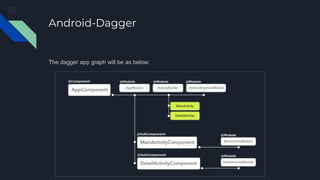Dependency injection using dagger2
- 1. Dependency Injection with Dagger2 M.Javad Hashemi
- 2. Dependency Injection ● A style of creation in which an object are created by an external entity or technique whereby one object supplies the dependencies of another object. ● IoC ( Inversion of Control) ○ The modules of top levels shouldn’t depend on modules of the lower levels. The modules of all levels should depend on abstractions. ○ The abstractions shouldn’t depend on details. The details should depend on abstractions.
- 3. Dependency Injection Benefits of DI ? ● Test ● Maintenance ● Reusable code
- 4. Dependency Injection class CoffeeMaker { private final Heater heater; private final Pump pump; public CoffeeMaker() { heater = new ElectricHeater(); pump = new Thermpsiphon(heater); } Coffee makeCaffee(){ /* ... */ } } class CoffeeMain { public static void main(String[] args){ Coffee coffee = new CoffeeMaker().makeCaffee(); } }
- 5. Dependency Injection class CoffeeMaker { private final Heater heater; private final Pump pump; public CoffeeMaker(Heater heater, Pump pump) { this.heater = heater; this.pump = pump; } Coffee makeCaffee(){ /* ... */ } } class CoffeeMain { public static void main(String[] args){ Heater heater = new ElectricHeater(); Pump pump = new Thermosiphon(heater) Coffee coffee = new CoffeeMaker(heater, pump).makeCaffee(); } }
- 6. Dagger2 ● Generate all the dependency injection boilerplate codes based on annotation processing ● Base elements: ○ @Inject ○ @Module/@Provide ○ @Component ○ @Scope ○ @Named/@Qualifier
- 7. @Inject Request dependency ● Constructor Injection ● Field Injection ● Method Injection the @Inject annotation will tell the "Dagger" which dependency needed to be passed to the dependant class. public class Starks{ /** * Explaining different usage * of Inject annotations of dagger **/ //Feild injection @Inject Allies allies; //Constructor injection @Inject public Starks(){ //do something.. } //Method injection @Inject private void prepareForWar(){ //do something.. } } COMPILE TIME CHECK !!!
- 8. @Module/@Provide @Module: Classes with methods “provide dependencies” @Provide: methods inside @Module, which “tell Dagger how we want to build and present a dependency“ @Module class DatabaseModule { @Provides fun provideRoomDatabase(application: App): AppDatabase { return Room .databaseBuilder(application, AppDatabase::class.java, Constants.DATABASE_NAME) .build() } @Provides fun provideDebitDao(appDatabase: AppDatabase): DebitDao { return appDatabase.getDebitDao() } }
- 9. @Component bridge between @Inject and @Module. @Component( modules = [ AndroidSupportInjectionModule::class, DatabaseModule::class, ] ) interface AppComponent : AndroidInjector<App> { @Component.Builder abstract class Builder : AndroidInjector.Builder<App>() } class App : Application() { override fun onCreate() { super.onCreate() DaggerAppComponent.builder().create(this) } }
- 10. @Component
- 11. @Scope ● When we want to share some variables across fragments but not across activities, then we need to have the variable that lives in activity scope. ● It’s main job is to ensure a variable is only created once and could be reused within a given scope. @Scope @kotlin.annotation.Retention(AnnotationRetention.RUNTIME) annotation class FragmentScope { } @Scope @kotlin.annotation.Retention(AnnotationRetention.RUN TIME) annotation class ActivityScope { }
- 12. @Named/@Qualifier ● We can’t provide two methods which returned the same Object ● So, how can do that ? @Module class CatModule { @Provides fun provideGarfield(): Cat = Cat("Garfield") @Provides fun provideHelloKitty(): Cat = Cat("Hello Kitty") } error: [Dagger/DuplicateBindings] packagename.something.something.Cat is bound multiple times:
- 13. @Named/@Qualifier ● The @Named annotation is good for identifying which provider to be used when we are trying to inject the dependency of the same type. @Module class CatModule { @Provides @Named("Garfield") fun provideGarfield(): Cat = Cat("Garfield") @Provides @Named("HelloKitty") fun provideHelloKitty(): Cat = Cat("Hello Kitty") } class QualifierActivity : AppCompatActivity() { @Inject @Named("Garfield") lateinit var garfield: Cat @Inject @Named("HelloKitty") lateinit var helloKitty: Cat override fun onCreate(savedInstanceState: Bundle?) { super.onCreate(savedInstanceState) setContentView(R.layout.activity_qualifier) DaggerCatComponent.builder().build().inject(this ) garfieldTextView.text = "injected: ${garfield.name}" helloKittyTextView.text = "injected: ${helloKitty.name}" } }
- 14. @Named/@Qualifier ● The @Qualifier is the same as @Named, but it is defined with custom annotation @Module class CatModule { @Provides @NamedClone("Red Apple") fun provideRedApple(): Apple = Apple("red") @Provides @NamedClone("Green Apple") fun provideGreenApple(): Apple = Apple("green") } @Qualifier @MustBeDocumented @Retention(AnnotationRetention.RUNTIME) annotation class NamedClone(val value: String = "") { } @Inject @field:NamedClone("Red Apple") lateinit var redApple: Apple @Inject @field:NamedClone("Green Apple") lateinit var greenApple: Apple
- 15. Is it the end? Not Yet !!! We Implement all dagger parts but something missing. Did you find it?
- 16. Android-Dagger ● Android Framework Components, like activity, fragment,... have no constructor injection support ● It is done by 4 steps:
- 17. Android-Dagger 1- AndroidInjectionModule An internal class from dagger 2.10 which provides our activities and fragments. That is why we have used it in Component modules: @Component( modules = [ AndroidInjectionModule::class, DatabaseModule::class, ] ) interface AppComponent : AndroidInjector<App> { @Component.Builder abstract class Builder : AndroidInjector.Builder<App>() }
- 18. Android-Dagger 2- ActivityBuilder It’s an module which map all of activities to help dagger knows our activities in compile time. Let’s imagine we have 2 activities : Main and Detail @Module public abstract class ActivityBuilder { @Binds @IntoMap @ActivityKey(MainActivity.class) abstract AndroidInjector.Factory<? extends Activity> bindMainActivity(MainActivityComponent.Builder builder); @Binds @IntoMap @ActivityKey(DetailActivity.class) abstract AndroidInjector.Factory<? extends Activity> bindDetailActivity(DetailActivityComponent.Builder builder); }
- 19. Android-Dagger 3- SubComponents We can think apps in three layers while using Dagger. ● Application Component (Must be one) ● Activity Component ● Fragment Component So. each Activity (also each Fragment) must have its own component. These are defined as SubComponents
- 20. Android-Dagger 3- SubComponents We have 2 Activities, so needs to create 2 subcomponents, and each activities have own specific modules, for example for mainActivity: @Subcomponent(modules = MainActivityModule.class) public interface MainActivityComponent extends AndroidInjector<MainActivity>{ @Subcomponent.Builder abstract class Builder extends AndroidInjector.Builder<MainActivity>{} } @Module public class MainActivityModule { //write provides methods }
- 21. Android-Dagger 3- SubComponents next , links subcomponent to the main components through appModule: @Module(subcomponents = [ MainActivityComponent::class, DetailActivityComponent::class]) class AppModule { @Provides @Singleton fun provideContext(Application application) : Context = return application }
- 22. Android-Dagger 4- DispatchingAndroidInjector<T> Applications has activities, That is why we implements app class from HasActivityInjector public class App extends Application implements HasActivityInjector { @Inject DispatchingAndroidInjector<Activity> activityDispatchingAndroidInjector; @Override public void onCreate() { super.onCreate(); //simplified } @Override public DispatchingAndroidInjector<Activity> activityInjector() { return activityDispatchingAndroidInjector; } }
- 23. Android-Dagger public class DetailActivity extends AppCompatActivity implements HasSupportFragmentInjector { @Inject DispatchingAndroidInjector<Fragment> fragmentDispatchingAndroidInjector; //simplified @Override public AndroidInjector<Fragment> supportFragmentInjector() { return fragmentDispatchingAndroidInjector; } } 4- DispatchingAndroidInjector<T> ● Also for activity class
- 24. Android-Dagger The dagger app graph will be as below:
- 25. Android-Dagger Finish? No! Because Activity and Fragment should not know about how it is injected. So how do we inject now? In Activity: @Override protected void onCreate(Bundle savedInstanceState) { AndroidInjection.inject(this); super.onCreate(savedInstanceState); } In Fragment: @Override public void onAttach(Context context) { AndroidSupportInjection.inject(this); super.onAttach(context); }
- 26. Is it too hard?? Let’s Simplified it
- 27. Android-Dagger Let’s look at dagger graph again, looks some classes can be removed.
- 28. Android-Dagger Instead of creating subcomponent, module, and boilerplate codes in each activity just use @ContributesAndroidInjector
- 29. Android-Dagger @ContributesAndroidInjector: Dagger Android introduced an annotation which can reduce the Binds, Subcomponent, ActivityKey, FragmentKey, etc boilerplate @Module public abstract class ActivityBuilder { @ContributesAndroidInjector(modules = MainActivityModule.class) abstract MainActivity bindMainActivity(); @ContributesAndroidInjector(modules = {DetailActivityModule.class}) abstract DetailActivity bindDetailActivity(); }
- 30. Android-Dagger ● Now, do not needs to implements android components classes from anymore interfaces. ● Just extends them from DaggerApplication, DaggerAppCompatActivity, DaggerFragment ● Finally, application class will be changed as follow:public class App extends DaggerApplication { @Override protected AndroidInjector<? extends AndroidSampleApp> applicationInjector() { return DaggerAppComponent.builder().create(this); } }
- 31. Thank you! Let’s try it in a real project!
Editor's Notes
- #19: This is the test




![Dependency Injection
class CoffeeMaker {
private final Heater heater;
private final Pump pump;
public CoffeeMaker() {
heater = new ElectricHeater();
pump = new Thermpsiphon(heater);
}
Coffee makeCaffee(){ /* ... */ }
}
class CoffeeMain {
public static void main(String[] args){
Coffee coffee = new CoffeeMaker().makeCaffee();
}
}](https://image.slidesharecdn.com/dependencyinjectionusingdagger2-190309103847/85/Dependency-injection-using-dagger2-4-320.jpg)
![Dependency Injection
class CoffeeMaker {
private final Heater heater;
private final Pump pump;
public CoffeeMaker(Heater heater, Pump pump) {
this.heater = heater;
this.pump = pump;
}
Coffee makeCaffee(){ /* ... */ }
}
class CoffeeMain {
public static void main(String[] args){
Heater heater = new ElectricHeater();
Pump pump = new Thermosiphon(heater)
Coffee coffee = new CoffeeMaker(heater, pump).makeCaffee();
}
}](https://image.slidesharecdn.com/dependencyinjectionusingdagger2-190309103847/85/Dependency-injection-using-dagger2-5-320.jpg)
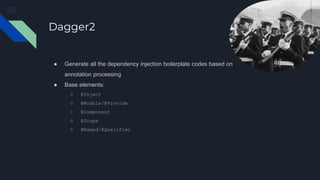


![@Component
bridge between @Inject and @Module.
@Component(
modules = [
AndroidSupportInjectionModule::class,
DatabaseModule::class,
]
)
interface AppComponent : AndroidInjector<App> {
@Component.Builder
abstract class Builder :
AndroidInjector.Builder<App>()
}
class App : Application() {
override fun onCreate() {
super.onCreate()
DaggerAppComponent.builder().create(this)
}
}](https://image.slidesharecdn.com/dependencyinjectionusingdagger2-190309103847/85/Dependency-injection-using-dagger2-9-320.jpg)


![@Named/@Qualifier
● We can’t provide two methods which returned
the same Object
● So, how can do that ?
@Module
class CatModule {
@Provides
fun provideGarfield(): Cat =
Cat("Garfield")
@Provides
fun provideHelloKitty(): Cat =
Cat("Hello Kitty")
}
error: [Dagger/DuplicateBindings]
packagename.something.something.Cat is bound
multiple times:](https://image.slidesharecdn.com/dependencyinjectionusingdagger2-190309103847/85/Dependency-injection-using-dagger2-12-320.jpg)

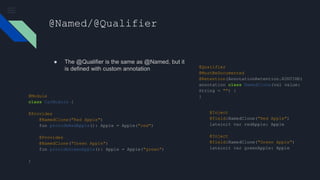
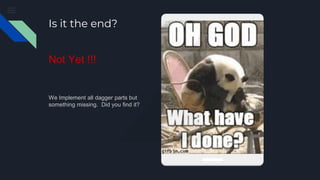

![Android-Dagger
1- AndroidInjectionModule
An internal class from dagger 2.10 which provides our activities and fragments. That is why we
have used it in Component modules:
@Component(
modules = [
AndroidInjectionModule::class,
DatabaseModule::class,
]
)
interface AppComponent : AndroidInjector<App> {
@Component.Builder
abstract class Builder :
AndroidInjector.Builder<App>()
}](https://image.slidesharecdn.com/dependencyinjectionusingdagger2-190309103847/85/Dependency-injection-using-dagger2-17-320.jpg)
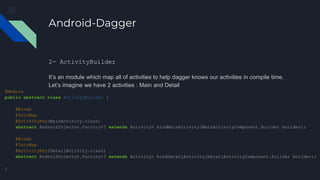
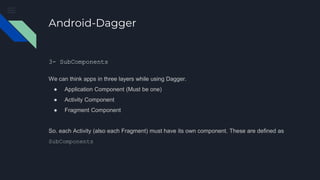
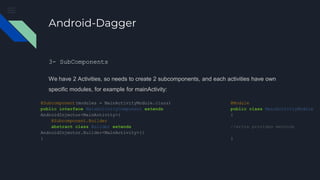
![Android-Dagger
3- SubComponents
next , links subcomponent to the main components through appModule:
@Module(subcomponents = [
MainActivityComponent::class,
DetailActivityComponent::class])
class AppModule {
@Provides
@Singleton
fun provideContext(Application application) : Context = return
application
}](https://image.slidesharecdn.com/dependencyinjectionusingdagger2-190309103847/85/Dependency-injection-using-dagger2-21-320.jpg)


